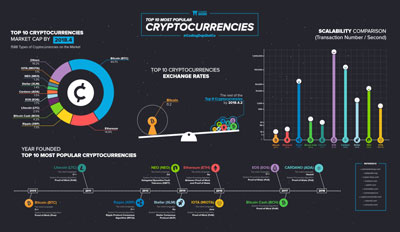
A cryptocurrency (or crypto currency) is a digital asset designed to work as a medium of exchange that uses strong cryptography to secure financial transactions, control the creation of additional units, and verify the transfer of assets. Cryptocurrencies are a kind of alternative currency and digital currency (of which virtual currency is a subset). Cryptocurrencies use decentralized control as opposed to centralized digital currency and central banking systems. The decentralized control of each cryptocurrency works through distributed ledger technology, typically a block chain, that serves as a public financial transaction database.
Bitcoin, first released as open-source software in 2009, is generally considered the first decentralized cryptocurrency. Since the release of Bitcoin, over 4,000 altcoins (alternative variants of Bitcoin, or other cryptocurrencies) have been created.
According to Jan Lansky, a cryptocurrency is a system that meets six conditions:

A block chain account can provide functions other than making payments, for example in decentralized applications or smart contracts. In this case, the units or coins are sometimes referred to as crypto tokens (or crypto tokens).
Decentralized cryptocurrency is produced by the entire cryptocurrency system collectively, at a rate which is defined when the system is created and which is publicly known. In centralized banking and economic systems such as the Federal Reserve System, corporate boards or governments control the supply of currency by printing units of fiat money or demanding additions to digital banking ledgers. In case of decentralized cryptocurrency, companies or governments cannot produce new units, and have not so far provided backing for other firms, banks or corporate entities which hold asset value measured in it. The underlying technical system upon which decentralized cryptocurrencies are based was created by the group or individual known as Satoshi Nakamoto.
As of May 2018, over 1,800 cryptocurrency specifications existed. Within a cryptocurrency system, the safety, integrity and balance of ledgers is maintained by a community of mutually distrustful parties referred to as miners: who use their computers to help validate and timestamp transactions, adding them to the ledger in accordance with a particular timestamping scheme.
Most cryptocurrencies are designed to gradually decrease production of that currency, placing a cap on the total amount of that currency that will ever be in circulation. Compared with ordinary currencies held by financial institutions or kept as cash on hand, cryptocurrencies can be more difficult for seizure by law enforcement.[1] This difficulty is derived from leveraging cryptographic technologies.
The validity of each cryptocurrency's coins is provided by a Blockchain. A Blockchain is a continuously growing list of records, called blocks, which are linked and secured using cryptography. Each block typically contains a hash pointer as a link to a previous block, a timestamp and transaction data by design, Blockchains are inherently resistant to modification of the data. It is "an open, distributed ledger that can record transactions between two parties efficiently and in a verifiable and permanent way". For use as a distributed ledger, a Blockchain is typically managed by a peer-to-peer network collectively adhering to a protocol for validating new blocks. Once recorded, the data in any given block cannot be altered retroactively without the alteration of all subsequent blocks, which requires collusion of the network majority.
Blockchains are secure by design and are an example of a distributed computing system with high Byzantine fault tolerance. Decentralized consensus has therefore been achieved with a Blockchain, It solves the double spending problem without the need of a trusted authority or central server.
The block time is the average time it takes for the network to generate one extra block in the block chain. Some Blockchains create a new block as frequently as every five seconds. By the time of block completion, the included data becomes verifiable. This is practically when the money transaction takes place, so a shorter block time means faster transactions.